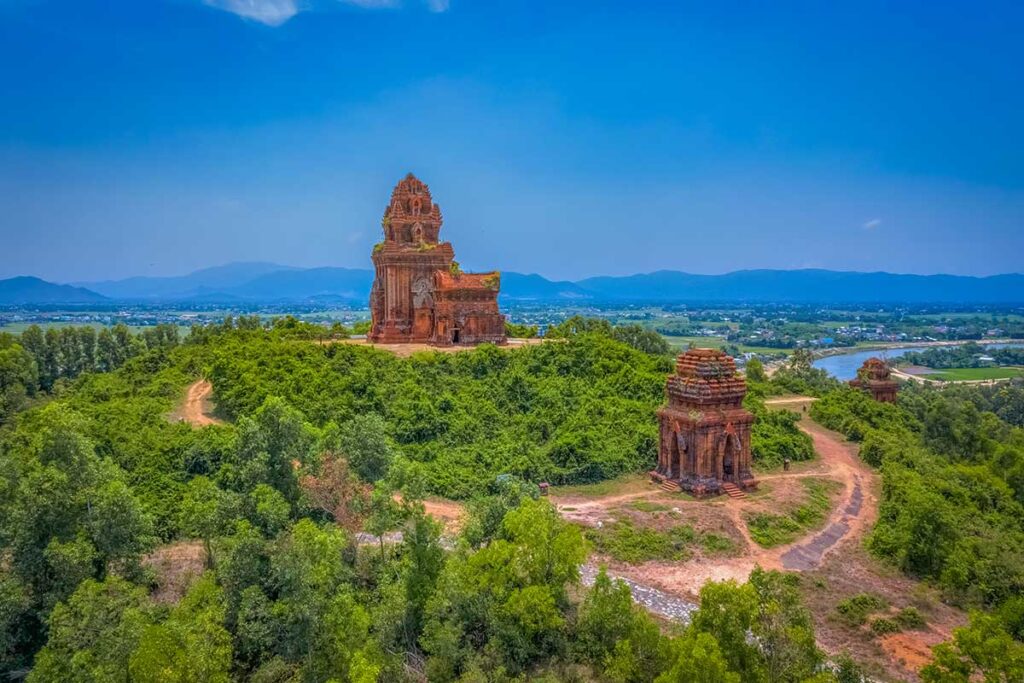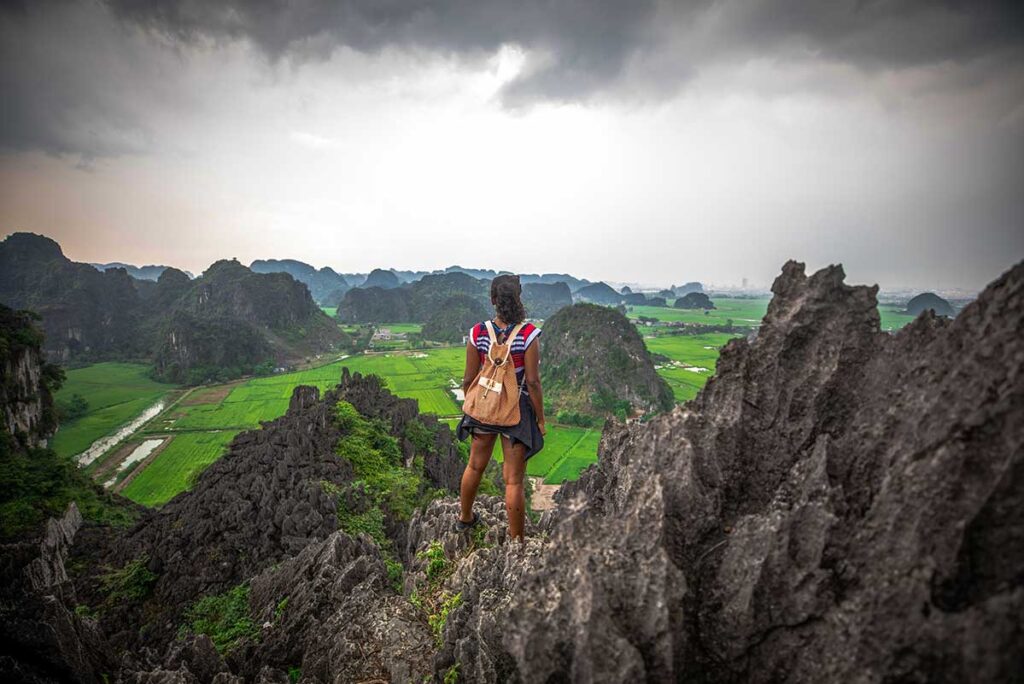What are the Banh It Towers?
Banh It Towers are a group of Cham temple towers set on a hill about 20 kilometers northwest of Quy Nhon. From their position high above the surrounding countryside, the towers look out over farmland and the Kon River, giving the site a striking backdrop that feels far removed from the city.

The name “Banh It” comes from a local sticky rice cake popular in Binh Dinh; when seen from a distance, the towers are said to resemble these pyramid-shaped cakes. Locals may also call them the Silver Towers or simply Cham Towers, but “Banh It” has stuck as the most common name.

The towers were built by the Cham people, an ethnic group who once ruled large parts of Central and Southern Vietnam under the Champa Kingdom. Strongly influenced by Hinduism, they left behind dozens of temple complexes across the region, often built with red bricks and decorated with carvings of Hindu deities, sacred animals, and floral motifs.
Banh It is one of the most complete Cham complexes in Binh Dinh, with four towers still standing. It has been recognized as a Special National Monument in Vietnam and even listed in the book 1001 Buildings You Must See Before You Die. While it may not be as famous as My Son near Hoi An, the quiet setting and relatively intact towers make it an important stop for those curious about Cham history and architecture.
History of the Banh It Towers
The Banh It Towers were built between the late 11th and early 12th century, when Binh Dinh was one of the main political and cultural centers of the Champa Kingdom. This period marked a peak in Cham power and artistry, and the towers reflect a blend of architectural styles—borrowing elements from the famous My Son A1 style while also showcasing the bold, heavier forms typical of the Binh Dinh region.
The complex served as a religious site dedicated to Hindu deities. Each tower had a specific purpose: the central Kalan to honor Brahma, the Stele Tower to Shiva, and the Fire Tower linked to cremation rituals. Reliefs and carvings once adorned the walls, depicting gods, dancers, and sacred animals, reflecting the Cham people’s Hindu beliefs and cosmology.
During the French colonial period, archaeologists uncovered important relics here, including statues of Shiva, Ganesh, Uma, and Brahma. Many of these were taken abroad and today can be seen in museums such as the Musée Guimet in Paris, leaving the towers themselves with fewer original sculptures.
Although time, weather, and human impact have caused damage, the towers remain relatively well-preserved compared to other Cham sites. Restoration work has stabilized the structures, though some parts have been altered or repaired. What stands today is a rare and impressive reminder of Champa’s influence in Central Vietnam, offering insight into both the artistic achievements and the religious life of this lost kingdom.
Highlights of visiting the Banh It Towers Today
1. The Main Tower (Kalan)
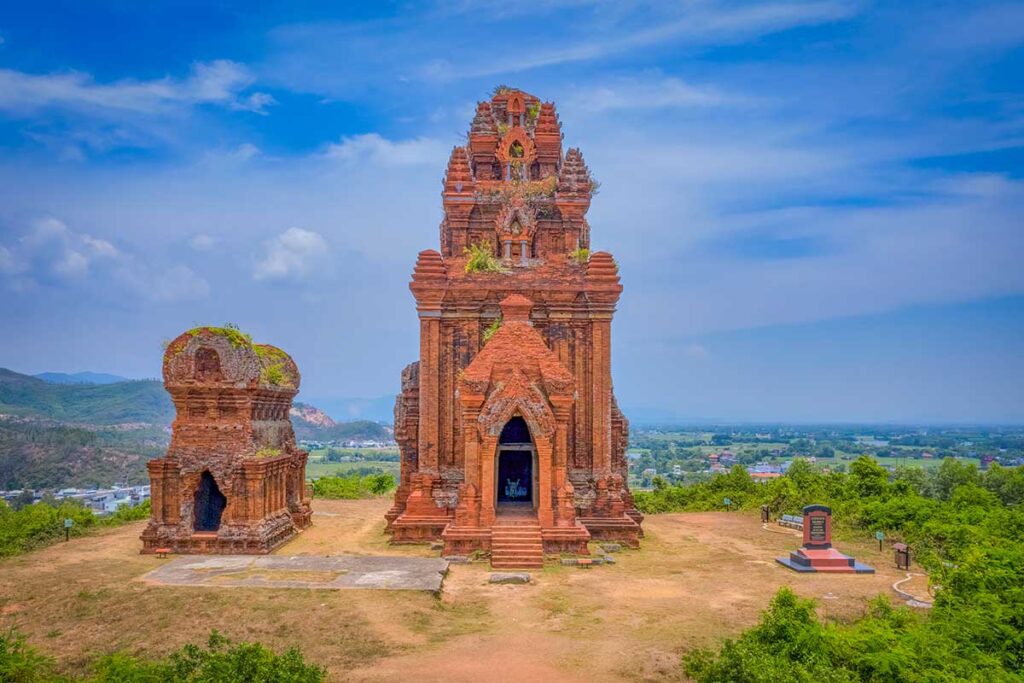
The central Kalan is the tallest and most impressive structure, rising between 22 and nearly 30 meters depending on different measurements. It was dedicated to Brahma, the creator in Hinduism, and served as the heart of the complex.


The square base, thick red-brick walls, and false gates on each side give it a monumental presence. Inside, some carvings remain, though parts have been damaged over time, including graffiti carved by visitors. Despite this, it still conveys the grandeur of Cham religious architecture.
2. The Gate Tower (Gopura)
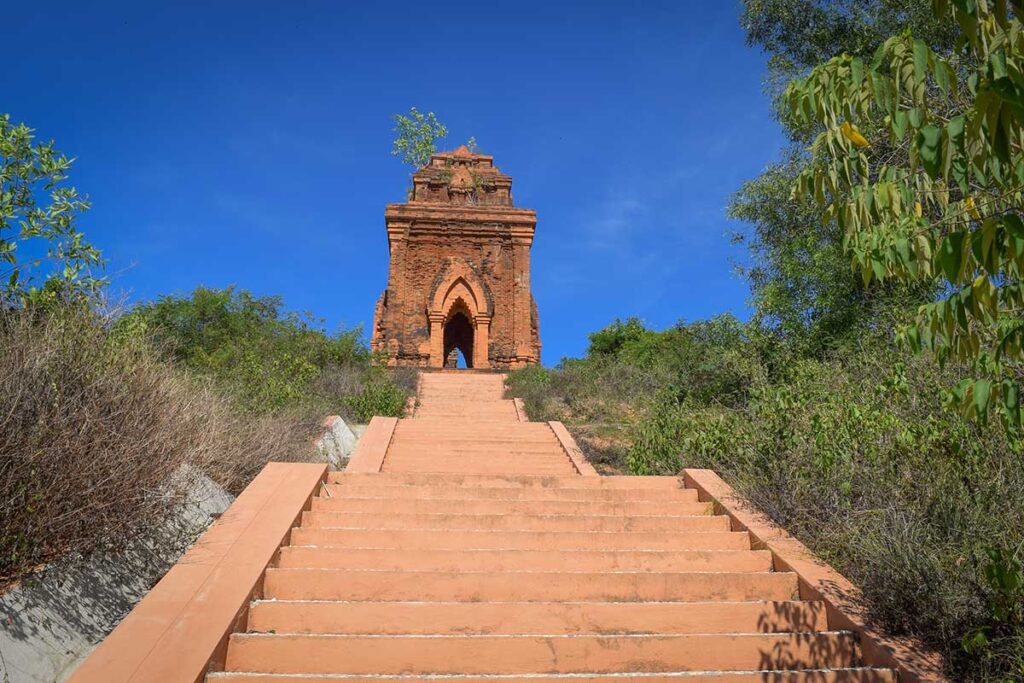
The first structure you encounter on the walk up is the Gopura, or Gate Tower. With four entrances facing different directions, it symbolically marks a passage into sacred space. Though smaller and simpler than the main temple, it sets the stage for the rest of the complex and gives you the sense of entering a spiritual site.
3. The Stele Tower (Posah)
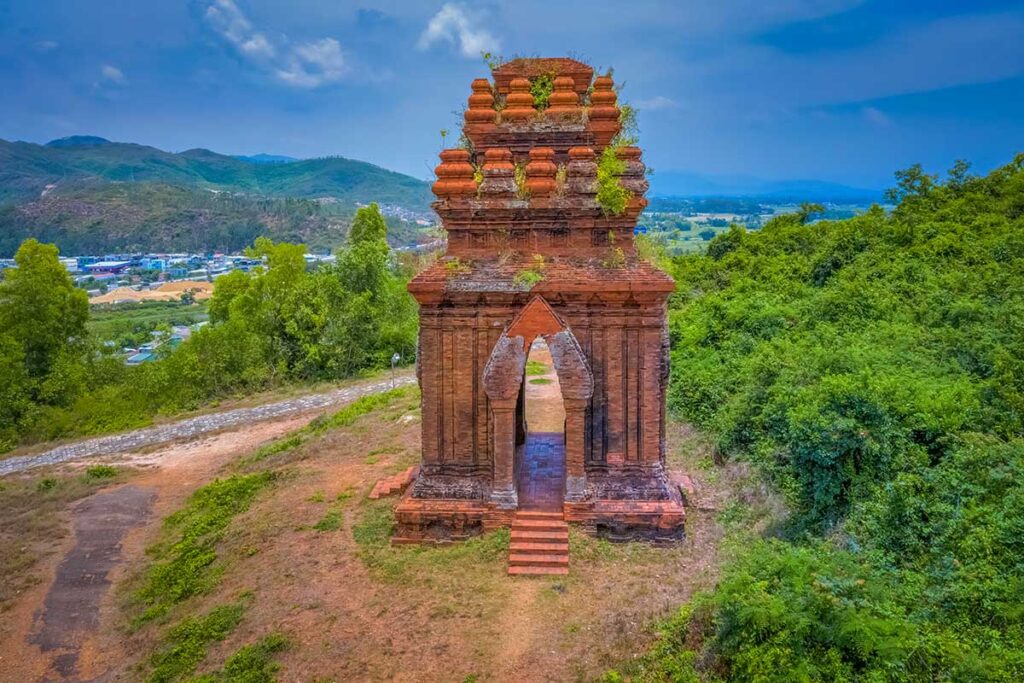
Located slightly apart from the others, the Stele Tower is linked to Shiva worship. Its square layout and distinct decorations make it easy to identify, with elegant details like curved motifs that soften the otherwise heavy brickwork. It is the least imposing of the four towers, but it adds to the completeness of the site.
4. The Fire Tower (Kosagrha)
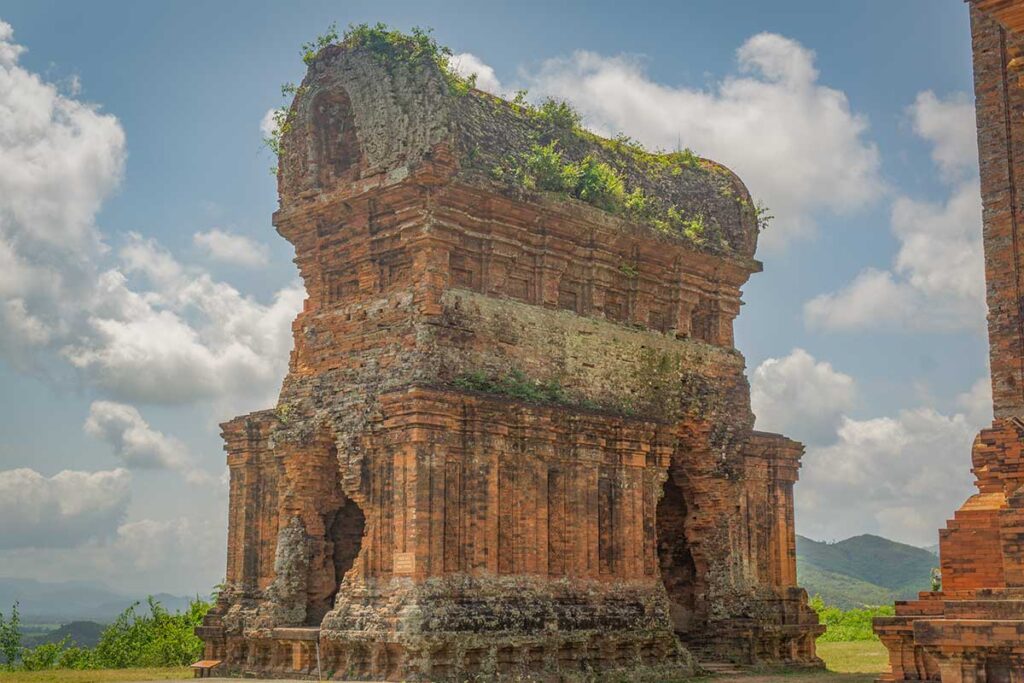
This tower is believed to have been associated with cremation rituals, tying into Hindu practices of fire as a purifying force. Architecturally, it stands out for its sculptural motifs, some of which resemble stylized animals and figures. Even though its symbolic use is no longer visible, the structure helps paint a picture of how diverse the functions of the complex once were.
5. Cham architecture & Decorative details
Banh It is a showcase of Cham artistry in the Binh Dinh style. The towers are built from red bricks, fitted together so precisely that mortar is almost invisible. Sandstone was used for decorative elements, which include leaf and flower patterns, dancing figures, and sacred animals. Reliefs once depicted Hindu gods like Shiva and Vishnu, along with everyday scenes of Cham life—agriculture, music, and dance. Many carvings have worn down, but enough details remain to appreciate the craftsmanship.
6. Scenic views from the hilltop

Because the towers sit high on a hill, the views are almost as much of a highlight as the monuments themselves. You can see across farmland, small villages, and the winding Kon River. Sunrise and sunset cast warm light on the red brick, making it a rewarding time for photography. Even at midday, the openness of the hilltop gives a panoramic perspective that contrasts with the coastal scenery of Quy Nhon.
7. Atmosphere & Photography
Unlike many better-known sites, Banh It is rarely crowded. Most visitors describe it as quiet and peaceful, with only a handful of others around. This makes it easier to take photos without people in the background. Ao dai rentals are sometimes available near the entrance, giving visitors the chance for traditional-style photos. For some, the combination of cultural heritage and dramatic views makes it a place worth visiting not only for history but also for memorable pictures.
Location and Getting there
Where are the Banh It Towers?
The Banh It Towers are located about 18–20 kilometers northwest of Quy Nhon, in Tuy Phuoc District. The journey takes around 30–40 minutes by road, passing through quiet countryside before you reach the hilltop site. From the top, you can look back toward Quy Nhon and out across farmland and the Kon River.
Taxi or Grab
Taking a taxi or using Grab is one of the easiest ways to get to the towers. The main drawback is finding a ride back—drivers don’t usually wait here unless you ask them to. Since most visits last less than an hour, it’s worth negotiating with the driver to wait for you, even if it means paying a slightly higher fare. Otherwise, you may end up needing to walk back to the main road and try to arrange another ride.
Private Car with Driver
Hiring a private car with driver is the most convenient option, especially if you want to combine the visit with other sights around Quy Nhon, such as Ky Co Beach, Eo Gio, or other Cham towers like Thap Doi. Prices are usually fixed per itinerary, so you won’t need to worry about return rides or timing. This option makes sense if you’re traveling in a group or prefer a smoother, hassle-free trip.
Motorbike
For independent travelers, renting a motorbike in Quy Nhon is the most flexible and affordable option. The roads to Banh It are relatively quiet compared to highways in larger cities, though you’ll still share them with buses and trucks in places. Officially, you need a Vietnamese license with an international driving permit to be fully covered, so keep this in mind. At the site, there’s free parking at the base, and locals sometimes offer to drive you up the hill on their own bikes for a small fee if you want to avoid the climb.
Practical information & Tips
Entrance Fee & Opening Times
The entry fee is around 20,000 VND per person (less than $1). Opening hours are generally from 7:00/7:30 am until 5:30/6:00 pm. If you arrive very early, there’s a small side path around the main gate that some visitors use to access the site before it officially opens.
Best time to visit
The best months to visit are during the dry season, from January to August. Even then, the biggest challenge is the heat: the hilltop is exposed and can get very hot in the middle of the day. Aim for an early morning visit when it’s cooler and quieter, or late afternoon for softer light. If you don’t mind an early start, sunrise can be spectacular and you may have the towers almost to yourself.
Dress code & Etiquette
Although the towers are no longer active temples, they are historical religious sites. Wear modest clothing out of respect. Comfortable shoes are recommended for the uphill walk and exploring around the ruins.
Facilities
Facilities on-site are basic. There is a small ticket office at the entrance and a parking area, but little else in terms of visitor infrastructure. Shade is limited, so bring water, sunscreen, and a hat. An exhibition hall has been mentioned but is not fully functional yet. Speakers sometimes play Vietnamese or even Persian music around the towers—something that visitors either find amusing or distracting. Don’t expect a museum-style experience; this is more of a raw heritage site.
Binh Dinh Museum
If you’d like more background on Cham history, the Binh Dinh Museum in Quy Nhon has a collection of Cham artifacts and sculptures found in this region. The museum also covers local history, including the Tay Son uprising and ethnographic displays about the province.
Other Cham Towers around Quy Nhon
If you’re interested in Cham architecture, Binh Dinh has several other towers worth seeing:
- Thap Doi (Cham Twin Towers): Located right in Quy Nhon city, easy to visit without leaving town.
- Canh Tien Tower: Smaller, less visited site with distinct style.
- Duong Long Towers: A more elaborate set of towers further out, sometimes called the most beautiful Cham towers in the province.
Visiting Banh It together with one or two of these gives a fuller picture of Cham heritage in Binh Dinh.
Are the Banh It Towers worth visiting?
Banh It Towers are worth visiting if you’re interested in Cham history, ancient architecture, or simply want a quiet stop outside Quy Nhon. The complex is small but impressive, with its red-brick towers standing tall on a hilltop that gives you wide views over the countryside. The peaceful setting and low entry fee make it a good value, and for photographers, the site is particularly rewarding at sunrise or sunset.
That said, there are downsides. The walk up is exposed and can be uncomfortably hot during the day, and once inside there isn’t much signage or explanation about the site. One tower has bats inside, and speakers sometimes play music that can take away from the atmosphere. It’s also a relatively quick stop—most people spend only 30 to 60 minutes here.
In short, Banh It Towers are not the kind of attraction that will appeal to everyone, but they are one of the more authentic Cham sites in the region. If you enjoy history, culture, or offbeat destinations, it’s well worth including in your Quy Nhon trip.
